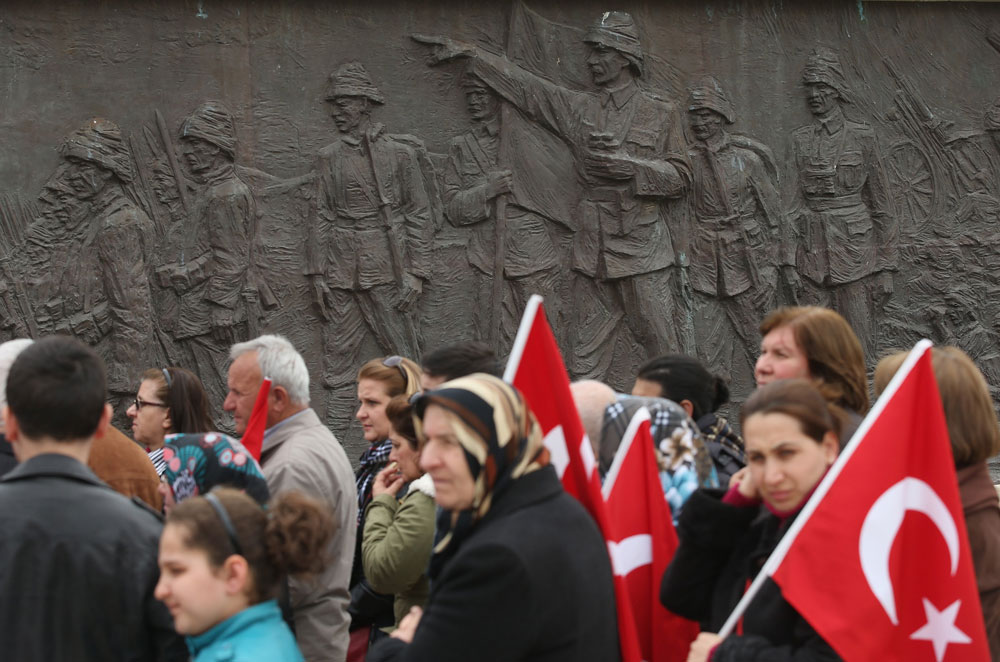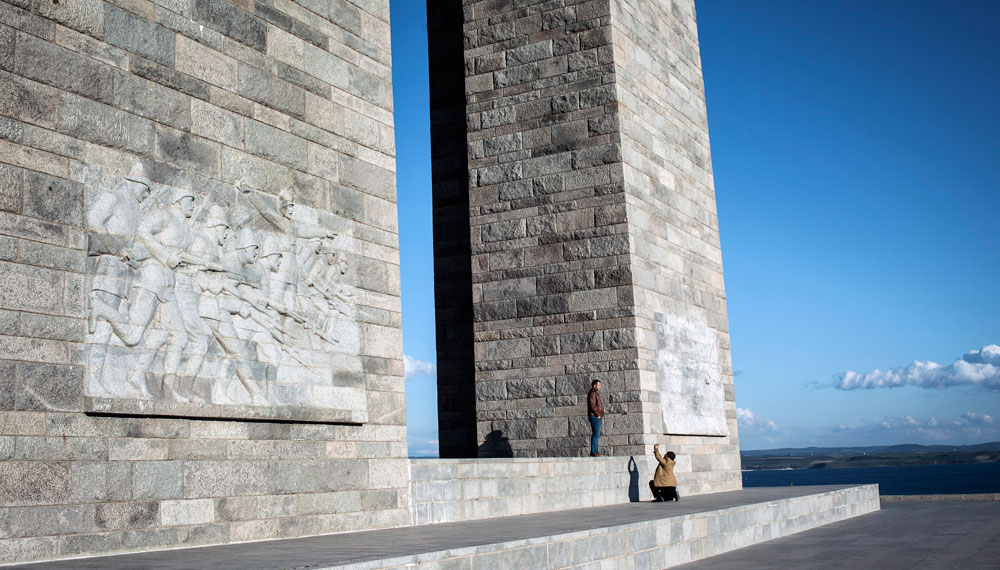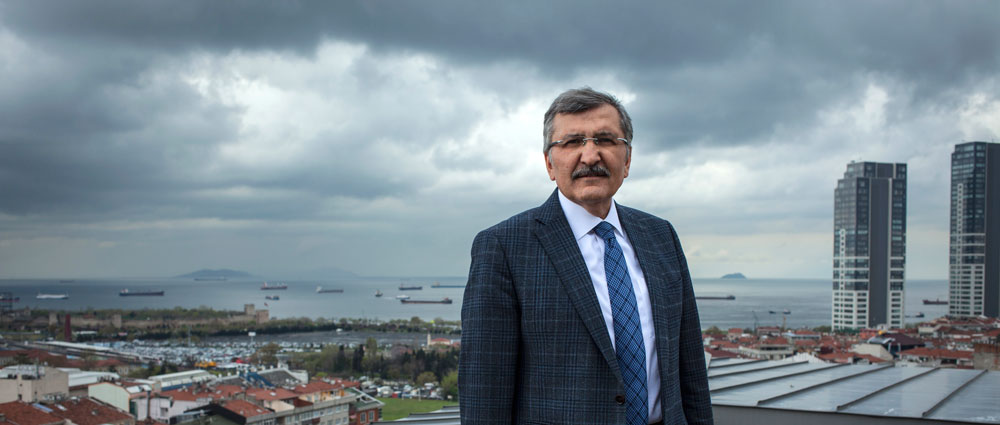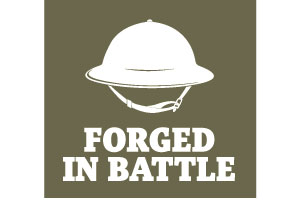
The battle to tell
the story of Gallipoli
It is the eve of the battle of Gallipoli. A lone soldier stands on a cliff singing a call to prayer while an enemy navy masses on the sea below. Huddled in a line of trenches, young men prepare to meet a hail of gunfire. Images of their descendants living in modern Turkey flit across the screen.
A voice filled with emotion – belonging to Turkish President Recep Tayyip Erdogan – begins to recite a poem: “Do not leave this motherland, moulded by Muslims, with no Muslims, my Allah! Give us strength ... Let us have the courage to fight back, do not leave us lifeless, my Allah!”
Designed to leave no viewer unmoved, the three-minute television commercial, which aired earlier this week, is a striking mix of patriotism and religious themes. The stirring background music swells as the advertisement reaches its conclusion: the President himself standing before the graves of Ottoman soldiers killed in the battle of Gallipoli, praying and paying his respects.
Follow this link to view a clutter-free version of the TV ad.
A hundred years after one of the bloodiest campaigns of the First World War, leaders from more than 20 countries have gathered in Turkey Friday and Saturday to commemorate the centenary of the battle of Gallipoli. The battle was a seminal event for Australia and New Zealand, who paid a heavy human toll which became central to their sense of nationhood. But it is also a crucial piece of history for Turkey, where the continuing struggle over what the battle means reflects a bitter debate over national identity.
In recent years, Mr. Erdogan’s ruling Justice and Development Party (AKP) has moved to alter the way the battle of Gallipoli is discussed and experienced, eliciting praise in some quarters and disgust in others. At the local level, it has mounted an unprecedented – and publicly funded – initiative to send Turks to visit the battlefields. It has de-emphasized the role of Mustafa Kemal Ataturk, Turkey’s secularist founder, who was a hero of the battle. And it has highlighted the place of Islam in motivating the Ottoman soldiers who fought there. Two years ago, for instance, Mr. Erdogan referred to Gallipoli as a modern-day Crusade.
“Every regime rewrites or distorts history,” said Ayhan Aktar, a professor at Istanbul Bilgi University who has studied Gallipoli. The current narrative emphasizes a conservative, religious-minded view, he said. “It’s extremely militaristic, emphasizing sacrifice and praising death,” said Prof. Aktar during an interview at Istanbul’s Taksim Square. He paused, smoked his cigarette and looked out on Gezi Park, the site where anti-government protests were violently suppressed two years ago.
“There has to be a new narrative asking why we entered this bloody war,” he said. “But anyone who asks this question will be treated like a lunatic.”
For Mr. Erdogan, the anniversary is an opportunity to advance his vision of a Turkey with a strongly Islamic character and neo-Ottoman aspirations. In particular, he is moving to cement his popularity ahead of critical parliamentary elections in early June. Mr. Erdogan is asking voters to give his party a majority a large enough to amend the Constitution in order to create a newly powerful presidency. If successful, such a move would continue what critics see as a dangerous slide in Turkey toward illiberal democracy, where one man – Mr. Erdogan – wields excessive power.
The anniversary also provides Mr. Erdogan with a chance to burnish his nationalist credentials. His government refuses to use the word “genocide” to describe the killings of up to 1.5 million Armenians starting in 1915, eight years before the creation of a fiercely secular, independent Turkey that rejected the faded Islamic pretensions of the Ottoman Empire.
In a move that enraged Armenia, Mr. Erdogan scheduled the international commemorations of Gallipoli for Friday, rather than on the traditional date of April 25. On April 24, 1915, the Ottoman Empire began imprisoning Armenian leaders. That date has long served as the commemoration of the subsequent mass killings.

The ‘Fifteen Generation’
At the tip of the Dardanelles peninsula stands a massive monument, a stark and modernist arch visible to all ships in nearby waters. Known as the Gallipoli Martyrs Memorial, it is Turkey’s tribute to those who fought and died there. On a recent afternoon, crowds of students and visitors roamed the area. Beyond it, the Aegean Sea sparkled under a powder blue sky.
The battle started from those waters. A French and British naval assault on March 18, 1915, was repulsed by Ottoman forces. Then a new land offensive involving troops from Australia, New Zealand, Britain and France began on April 25. For months, battles raged across the peninsula. In September, a regiment from Newfoundland joined the fight. Soldiers endured trench warfare, hunger, disease, a searing summer and a brutal winter before the Allied forces withdrew in January 1916. An estimated 87,000 Ottoman and 44,000 Allied troops died. At least 200,000 more soldiers were wounded.
The battle occupies a central role in Turkey, where it is known as Canakkale and considered a precursor to its own war of independence. It is the subject of countless books and films; when a soccer team here is mounting a robust defence, viewers comment that the players are engaged in a “Gallipoli defence.”
For years, Gallipoli was part of the project of building a secular, nationalist Turkey in the shadow of its larger-than-life founder Ataturk. The teaching of the battle inflated his role and Gallipoli was presented as a fundamentally Turkish struggle, ignoring the fact that Ottoman troops came from all over the then-empire (and that the Empire lost the broader war).
Under Mr. Erdogan, the narrative has shifted to highlight the role of faith and sacrifice. Mr. Erdogan came to power in 2002 as a reformer who represented a brand of Islam at ease with democracy. His critics now say he intends to rival Ataturk and become a new sultan. (Of course, his version of Islamist politics is very different from the visions of a repressive caliphate based on seventh-century precepts that are promoted by groups like the extremist Islamic State, or ISIS, which are alarming and disturbing to Turks.)

A recent visit to Gallipoli revealed how the older narrative about the battle has receded. In a dozen interviews, no visitor mentioned Ataturk. Instead, many talked about how visiting the battlefield filled them with respect and appreciation for their forefathers and expressed militaristic pride.
“I get very proud when I get here,” said Huseyin Kocyigit, smiling broadly, flanked by his wife and son. All three wore red caps identifying them as part of a bus tour organized by their municipality in Istanbul. “We have some peace in this country due to their sacrifice,” he said. His wife Nurten, who was seeing Gallipoli for the first time, said her grandfather had died in the battle and she grew up hearing stories of the difficult life her grandmother led as a widow.
Ali, an imam from the city of Tekirdag, 200 kilometres away, was visiting for the third time with his wife and two children (he declined to give his last name). He said he speaks to his congregants each year about the lessons of Gallipoli. “Our religious spirit and our nationalism are one.” he said. “Our Islam is in the head and the heart at the same time, and that is the spirit of Canakkale.”
Not long after he spoke, a group of about 30 teenaged boys gathered near the entrance to the memorial. Dressed in Ottoman soldier uniforms, they marched down a path through the grave markers carrying a banner and Turkish flags. The banner proclaimed their solidarity with the young soldiers – some no more than 15 years old – who fought in the battle. These boys, too, were 15, from the city of Turhal in central Turkey.
“I’m very proud to be in this uniform, to be a son of Turkey,” said a 15-year-old in the group named Mert. “We have beaten the entire world and taken control of our land.”

A Half-pilgrimage
Beylikduzu. Bagcilar. Gunggoren. Avcilar. Sultangari. Bursa. In the parking lot leading to the memorial sit tour buses bearing the names of cities and towns from around the country. Many are painted with special images and slogans honouring the 100th anniversary of the battle.
In recent years, visits to Gallipoli have exploded. More than two million people are expected to visit the battlefields this year, according to the local tourism authority. That’s more than double the number of visitors recorded by the national park service in 2011, and ten times the number in 2002.
The vast majority of the visitors are Turkish and the increase is not serendipitous. To understand the phenomenon, it helps to visit Zeytinburnu, one of Istanbul’s numerous municipal districts and a stronghold of Mr. Erdogan’s party. Murat Aydin, the long-serving president of the borough, greets visitors in a brand new eight-storey headquarters.
Fifteen years ago, Mr. Aydin traveled to Australia and was struck by the deeply-felt connection to the battle of Gallipoli. He resolved to bring the residents of his municipality to the battlefields, about a five-hour drive from the city. “Canakkale is the womb out of which the Turkish Republic came,” said Mr. Aydin. “Our forefathers united and fought together.”
Zeytinburnu, a working-class district not far from one of Istanbul’s airports, began sending residents on free day-long bus tours to Gallipoli. The tours begin in late April and run for four months. Every day, several busloads of people depart from the municipality. The budget for this year’s trips is 780,000 Turkish lira ($350,000). According to Mr. Aydin’s rough estimate, to date about 200,000 of his constituents have participated in the tours – or two out of every three people in Zeytinburnu.
It can be an emotional trip. Some visitors liken it to a half a pilgrimage to Mecca, Mr. Aydin added. “They cry, they want to go back again. They empathize with those who died.”
The trips have been replicated by municipalities across the country. The ruling party has also found other novel ways to incorporate Gallipoli into its religious-minded nationalism. The Istanbul branch of the party has begun organizing an event during the month of Ramadan where thousands attend an Iftar meal – the breaking of the daily fast – at the Gallipoli Martyrs Memorial. The menu is a crust of bread, a couple of olives and a bowl of weak soup, a simulation of the meagre fare eaten by Ottoman soldiers during the long, terrible battle.
Some Turks find such events reprehensible. Serdar Degirmencioglu, a professor at Dogus University in Istanbul, recently published a collection of essays on Turkey’s approach to martyrdom. It includes a chapter on what Prof. Degirmencioglu calls “martyr tourism” at Gallipoli.
The battle is now being portrayed as “a victory of faith,” he said. “How is it won? By dying. The emphasis is on dying for a larger cause.” The government is also hoping the free trips turn into votes and support for the ruling party, he added. “I see no end to it. It’s clear that this is a very useful game for the current government.”

Politics and tactics
On Friday, the prime ministers of Australia and New Zealand, Britain’s Prince Charles and Prince Harry, and representatives of a host of other countries took part in solemn commemorations at Gallipoli. Back in Istanbul, the Armenian community gathered in Taksim Square in the evening to remember the victims of what they call the genocide.
Pakrat Estukyan, a writer and editor at Agos, an Armenian weekly in Istanbul, criticized the Turkish government’s scheduling gambit as “a political, tactical move.” The weekly put out a special issue to commemorate the centenary of the start of the killings. It included remembrances from those who heard stories from their parents of what happened; a hundred years later, many refused to allow their full names to be printed out of a sense of fear.
Across town, at the offices of Dirilis Postasi, a new newspaper that supports the ruling party, Hakan Albayrak, its energetic editor, expressed both regret and dismay. “Of course there were mass killings,” he said. But who killed whom and in what numbers, he declined to specify. Meanwhile, by focusing on the acknowledgment of genocide, Armenia “has chosen not to be a nation but a sad memory of a nation of the past,” he asserted.
A hundred years after Gallipoli and the beginning of the Armenian genocide, Turkey continues to grapple with the consequences of those events for its politics. Sometimes, said Prof. Aktar of Istanbul Bilgi University, it almost seems like a contest of pain – “not a beauty contest, but a death contest.”
